Auxiliary Boiler Failure in Maersk Doha: A Case Study
VerifiedAdded on 2023/04/06
|9
|1695
|90
AI Summary
This case study examines the auxiliary boiler failure in the container vessel Maersk Doha, leading to a fire incident. The probable cause of the fire was the malfunction of the auxiliary boiler control mechanism. The study highlights the importance of safety systems and monitoring water levels in boilers to prevent accidents.
Contribute Materials
Your contribution can guide someone’s learning journey. Share your
documents today.

MARINE ENGINEERING
By Name
Course
Instructor
Institution
Location
Date
By Name
Course
Instructor
Institution
Location
Date
Secure Best Marks with AI Grader
Need help grading? Try our AI Grader for instant feedback on your assignments.
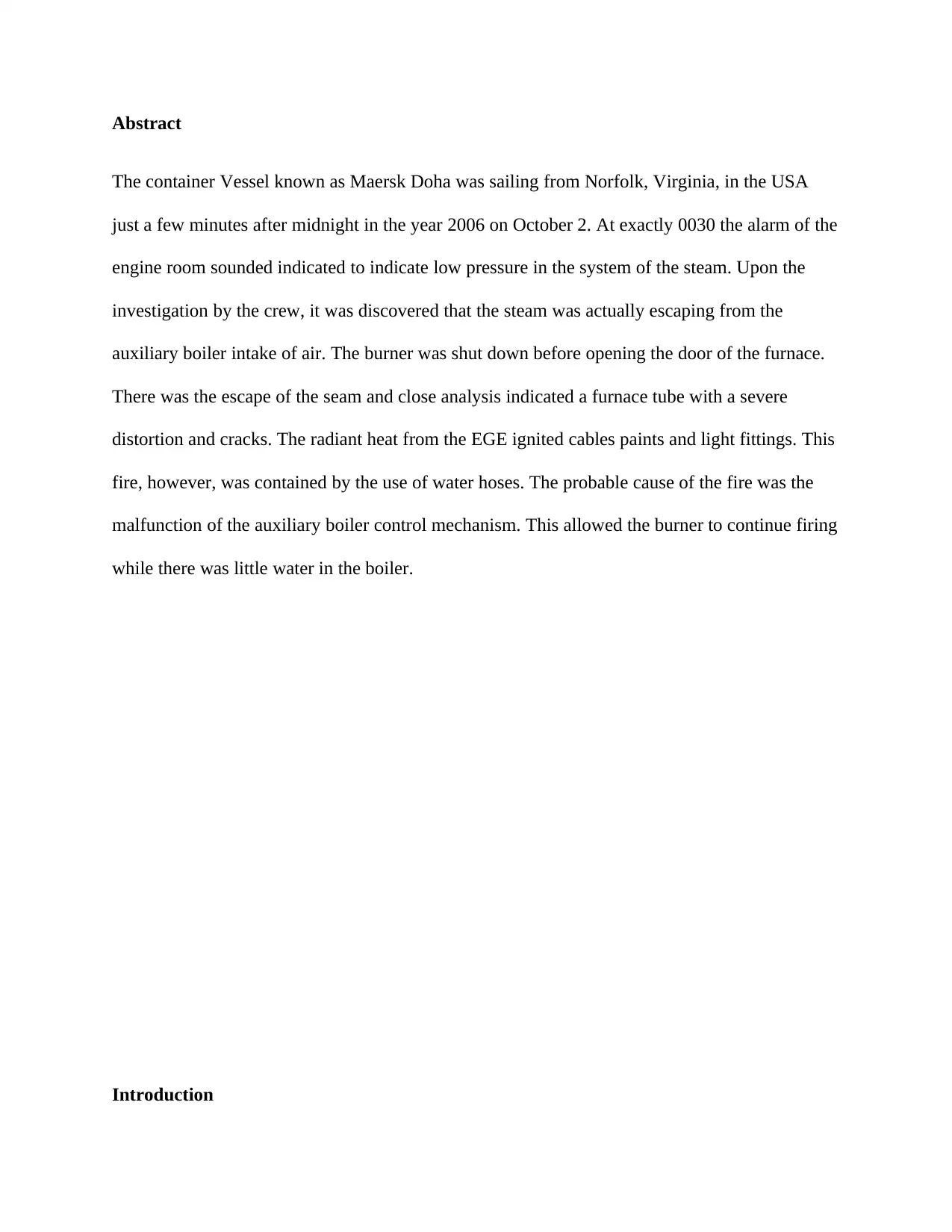
Abstract
The container Vessel known as Maersk Doha was sailing from Norfolk, Virginia, in the USA
just a few minutes after midnight in the year 2006 on October 2. At exactly 0030 the alarm of the
engine room sounded indicated to indicate low pressure in the system of the steam. Upon the
investigation by the crew, it was discovered that the steam was actually escaping from the
auxiliary boiler intake of air. The burner was shut down before opening the door of the furnace.
There was the escape of the seam and close analysis indicated a furnace tube with a severe
distortion and cracks. The radiant heat from the EGE ignited cables paints and light fittings. This
fire, however, was contained by the use of water hoses. The probable cause of the fire was the
malfunction of the auxiliary boiler control mechanism. This allowed the burner to continue firing
while there was little water in the boiler.
Introduction
The container Vessel known as Maersk Doha was sailing from Norfolk, Virginia, in the USA
just a few minutes after midnight in the year 2006 on October 2. At exactly 0030 the alarm of the
engine room sounded indicated to indicate low pressure in the system of the steam. Upon the
investigation by the crew, it was discovered that the steam was actually escaping from the
auxiliary boiler intake of air. The burner was shut down before opening the door of the furnace.
There was the escape of the seam and close analysis indicated a furnace tube with a severe
distortion and cracks. The radiant heat from the EGE ignited cables paints and light fittings. This
fire, however, was contained by the use of water hoses. The probable cause of the fire was the
malfunction of the auxiliary boiler control mechanism. This allowed the burner to continue firing
while there was little water in the boiler.
Introduction
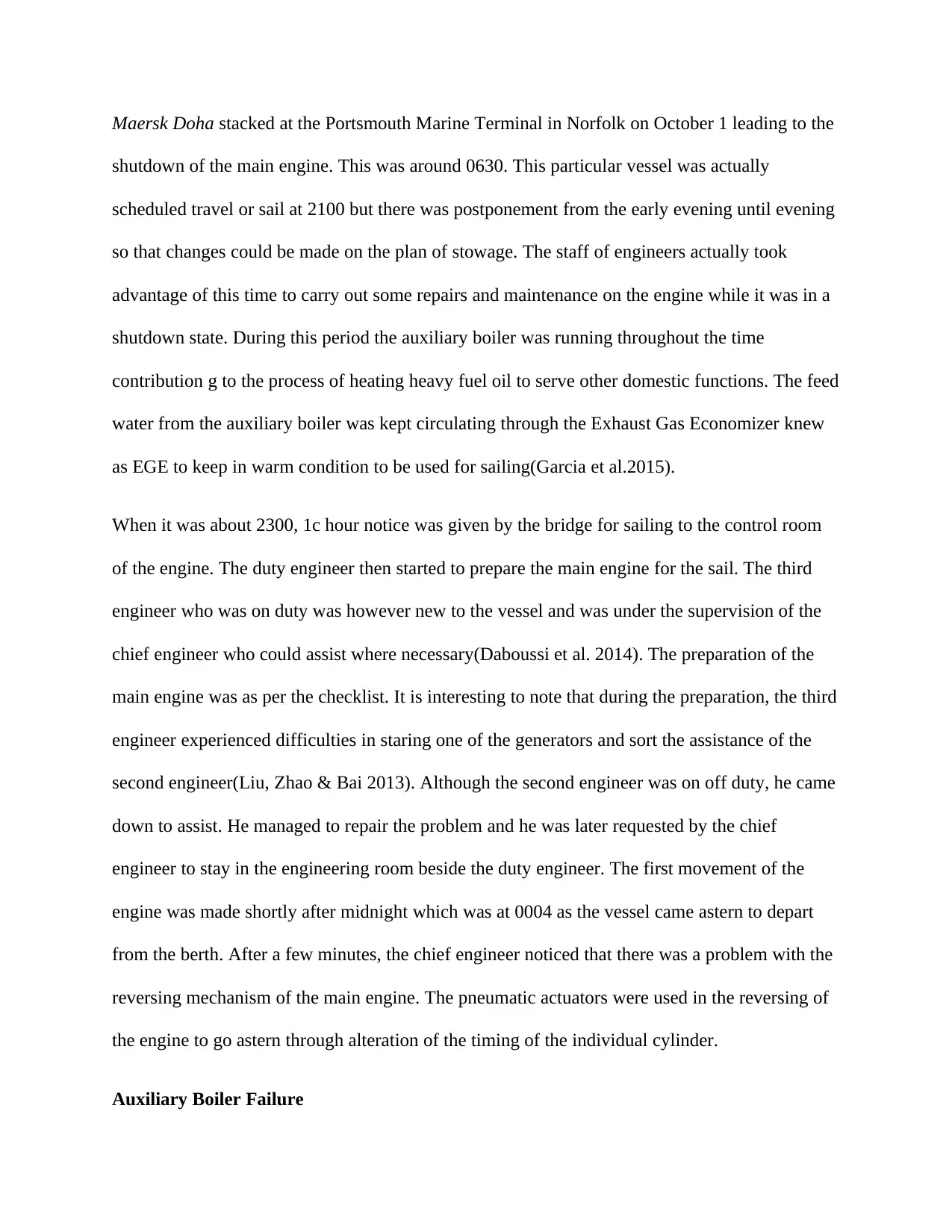
Maersk Doha stacked at the Portsmouth Marine Terminal in Norfolk on October 1 leading to the
shutdown of the main engine. This was around 0630. This particular vessel was actually
scheduled travel or sail at 2100 but there was postponement from the early evening until evening
so that changes could be made on the plan of stowage. The staff of engineers actually took
advantage of this time to carry out some repairs and maintenance on the engine while it was in a
shutdown state. During this period the auxiliary boiler was running throughout the time
contribution g to the process of heating heavy fuel oil to serve other domestic functions. The feed
water from the auxiliary boiler was kept circulating through the Exhaust Gas Economizer knew
as EGE to keep in warm condition to be used for sailing(Garcia et al.2015).
When it was about 2300, 1c hour notice was given by the bridge for sailing to the control room
of the engine. The duty engineer then started to prepare the main engine for the sail. The third
engineer who was on duty was however new to the vessel and was under the supervision of the
chief engineer who could assist where necessary(Daboussi et al. 2014). The preparation of the
main engine was as per the checklist. It is interesting to note that during the preparation, the third
engineer experienced difficulties in staring one of the generators and sort the assistance of the
second engineer(Liu, Zhao & Bai 2013). Although the second engineer was on off duty, he came
down to assist. He managed to repair the problem and he was later requested by the chief
engineer to stay in the engineering room beside the duty engineer. The first movement of the
engine was made shortly after midnight which was at 0004 as the vessel came astern to depart
from the berth. After a few minutes, the chief engineer noticed that there was a problem with the
reversing mechanism of the main engine. The pneumatic actuators were used in the reversing of
the engine to go astern through alteration of the timing of the individual cylinder.
Auxiliary Boiler Failure
shutdown of the main engine. This was around 0630. This particular vessel was actually
scheduled travel or sail at 2100 but there was postponement from the early evening until evening
so that changes could be made on the plan of stowage. The staff of engineers actually took
advantage of this time to carry out some repairs and maintenance on the engine while it was in a
shutdown state. During this period the auxiliary boiler was running throughout the time
contribution g to the process of heating heavy fuel oil to serve other domestic functions. The feed
water from the auxiliary boiler was kept circulating through the Exhaust Gas Economizer knew
as EGE to keep in warm condition to be used for sailing(Garcia et al.2015).
When it was about 2300, 1c hour notice was given by the bridge for sailing to the control room
of the engine. The duty engineer then started to prepare the main engine for the sail. The third
engineer who was on duty was however new to the vessel and was under the supervision of the
chief engineer who could assist where necessary(Daboussi et al. 2014). The preparation of the
main engine was as per the checklist. It is interesting to note that during the preparation, the third
engineer experienced difficulties in staring one of the generators and sort the assistance of the
second engineer(Liu, Zhao & Bai 2013). Although the second engineer was on off duty, he came
down to assist. He managed to repair the problem and he was later requested by the chief
engineer to stay in the engineering room beside the duty engineer. The first movement of the
engine was made shortly after midnight which was at 0004 as the vessel came astern to depart
from the berth. After a few minutes, the chief engineer noticed that there was a problem with the
reversing mechanism of the main engine. The pneumatic actuators were used in the reversing of
the engine to go astern through alteration of the timing of the individual cylinder.
Auxiliary Boiler Failure
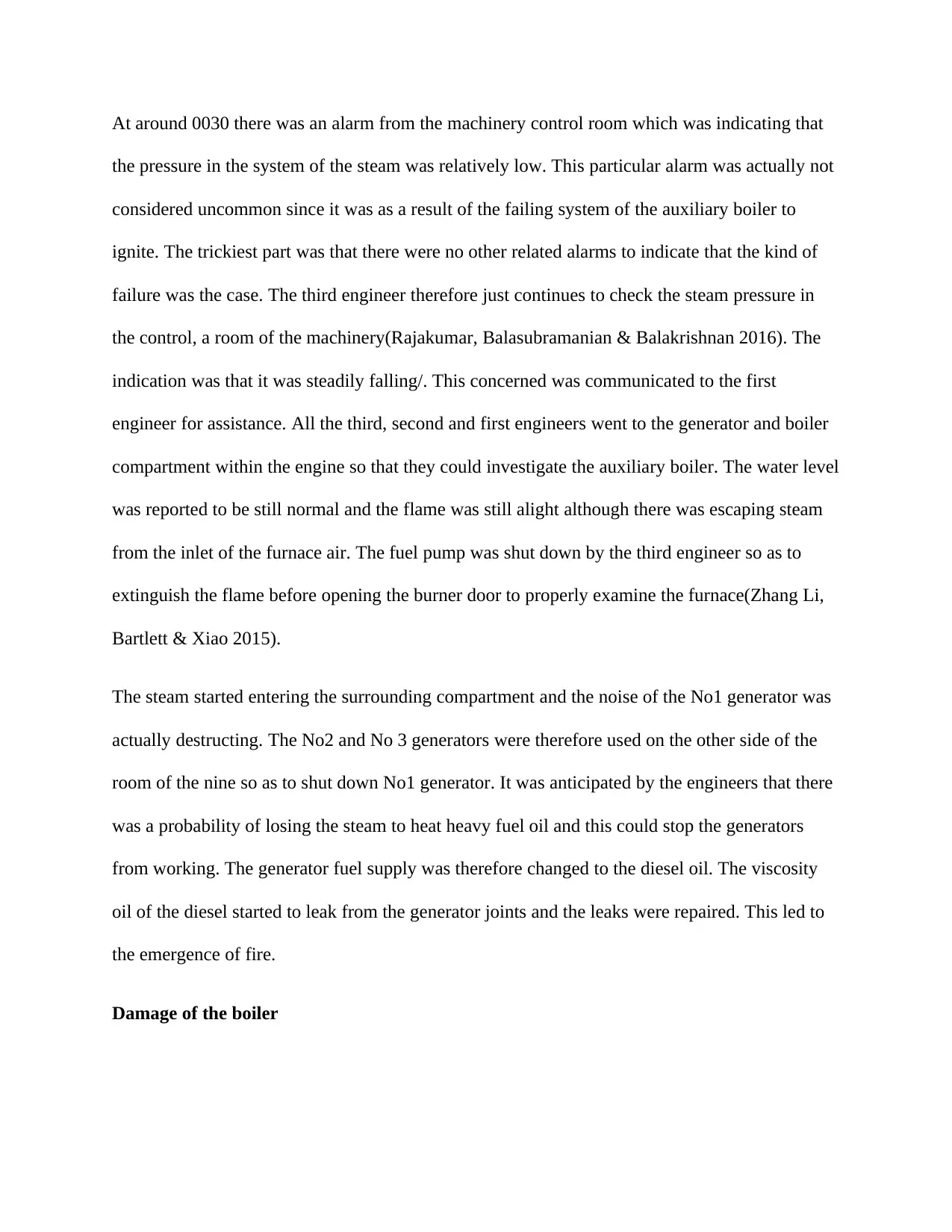
At around 0030 there was an alarm from the machinery control room which was indicating that
the pressure in the system of the steam was relatively low. This particular alarm was actually not
considered uncommon since it was as a result of the failing system of the auxiliary boiler to
ignite. The trickiest part was that there were no other related alarms to indicate that the kind of
failure was the case. The third engineer therefore just continues to check the steam pressure in
the control, a room of the machinery(Rajakumar, Balasubramanian & Balakrishnan 2016). The
indication was that it was steadily falling/. This concerned was communicated to the first
engineer for assistance. All the third, second and first engineers went to the generator and boiler
compartment within the engine so that they could investigate the auxiliary boiler. The water level
was reported to be still normal and the flame was still alight although there was escaping steam
from the inlet of the furnace air. The fuel pump was shut down by the third engineer so as to
extinguish the flame before opening the burner door to properly examine the furnace(Zhang Li,
Bartlett & Xiao 2015).
The steam started entering the surrounding compartment and the noise of the No1 generator was
actually destructing. The No2 and No 3 generators were therefore used on the other side of the
room of the nine so as to shut down No1 generator. It was anticipated by the engineers that there
was a probability of losing the steam to heat heavy fuel oil and this could stop the generators
from working. The generator fuel supply was therefore changed to the diesel oil. The viscosity
oil of the diesel started to leak from the generator joints and the leaks were repaired. This led to
the emergence of fire.
Damage of the boiler
the pressure in the system of the steam was relatively low. This particular alarm was actually not
considered uncommon since it was as a result of the failing system of the auxiliary boiler to
ignite. The trickiest part was that there were no other related alarms to indicate that the kind of
failure was the case. The third engineer therefore just continues to check the steam pressure in
the control, a room of the machinery(Rajakumar, Balasubramanian & Balakrishnan 2016). The
indication was that it was steadily falling/. This concerned was communicated to the first
engineer for assistance. All the third, second and first engineers went to the generator and boiler
compartment within the engine so that they could investigate the auxiliary boiler. The water level
was reported to be still normal and the flame was still alight although there was escaping steam
from the inlet of the furnace air. The fuel pump was shut down by the third engineer so as to
extinguish the flame before opening the burner door to properly examine the furnace(Zhang Li,
Bartlett & Xiao 2015).
The steam started entering the surrounding compartment and the noise of the No1 generator was
actually destructing. The No2 and No 3 generators were therefore used on the other side of the
room of the nine so as to shut down No1 generator. It was anticipated by the engineers that there
was a probability of losing the steam to heat heavy fuel oil and this could stop the generators
from working. The generator fuel supply was therefore changed to the diesel oil. The viscosity
oil of the diesel started to leak from the generator joints and the leaks were repaired. This led to
the emergence of fire.
Damage of the boiler
Secure Best Marks with AI Grader
Need help grading? Try our AI Grader for instant feedback on your assignments.
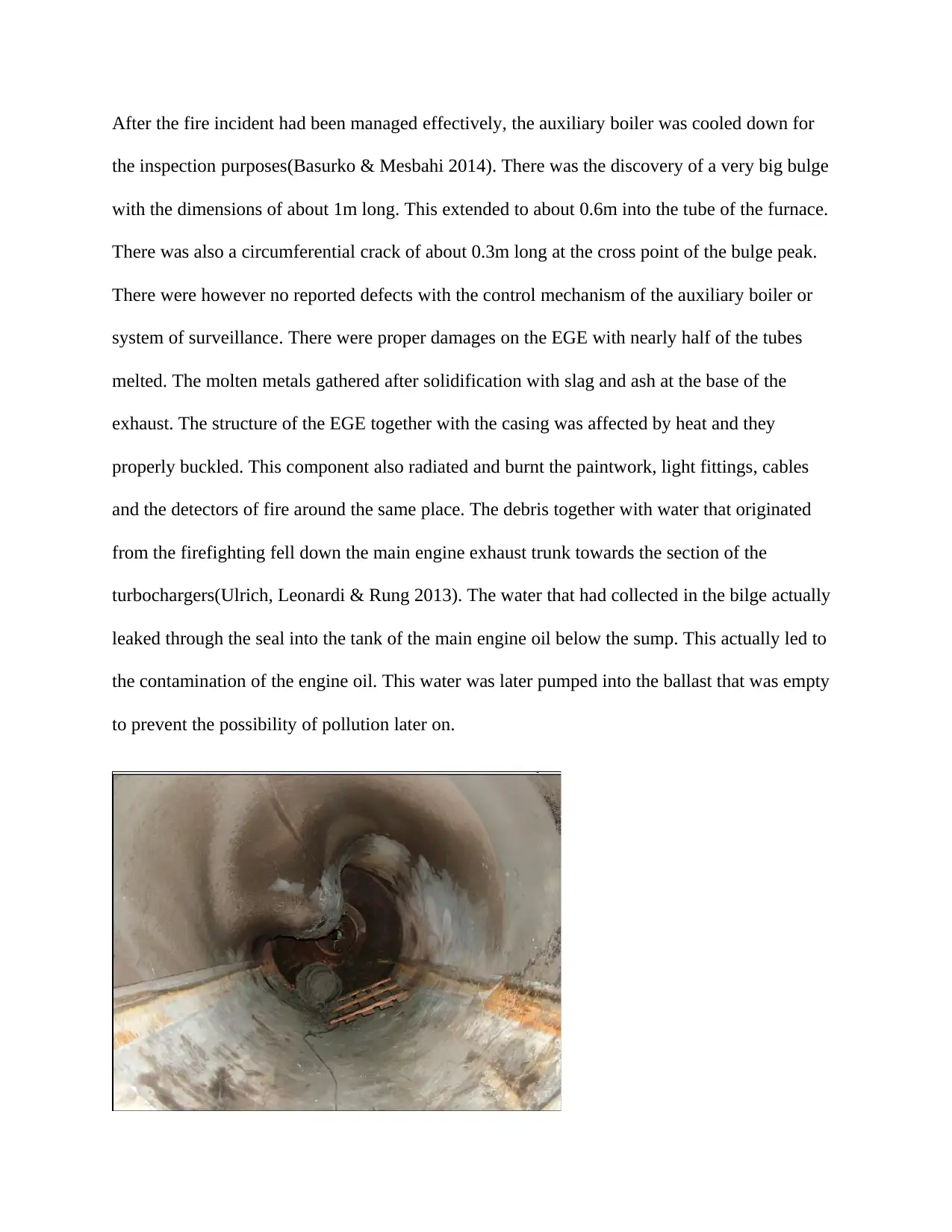
After the fire incident had been managed effectively, the auxiliary boiler was cooled down for
the inspection purposes(Basurko & Mesbahi 2014). There was the discovery of a very big bulge
with the dimensions of about 1m long. This extended to about 0.6m into the tube of the furnace.
There was also a circumferential crack of about 0.3m long at the cross point of the bulge peak.
There were however no reported defects with the control mechanism of the auxiliary boiler or
system of surveillance. There were proper damages on the EGE with nearly half of the tubes
melted. The molten metals gathered after solidification with slag and ash at the base of the
exhaust. The structure of the EGE together with the casing was affected by heat and they
properly buckled. This component also radiated and burnt the paintwork, light fittings, cables
and the detectors of fire around the same place. The debris together with water that originated
from the firefighting fell down the main engine exhaust trunk towards the section of the
turbochargers(Ulrich, Leonardi & Rung 2013). The water that had collected in the bilge actually
leaked through the seal into the tank of the main engine oil below the sump. This actually led to
the contamination of the engine oil. This water was later pumped into the ballast that was empty
to prevent the possibility of pollution later on.
the inspection purposes(Basurko & Mesbahi 2014). There was the discovery of a very big bulge
with the dimensions of about 1m long. This extended to about 0.6m into the tube of the furnace.
There was also a circumferential crack of about 0.3m long at the cross point of the bulge peak.
There were however no reported defects with the control mechanism of the auxiliary boiler or
system of surveillance. There were proper damages on the EGE with nearly half of the tubes
melted. The molten metals gathered after solidification with slag and ash at the base of the
exhaust. The structure of the EGE together with the casing was affected by heat and they
properly buckled. This component also radiated and burnt the paintwork, light fittings, cables
and the detectors of fire around the same place. The debris together with water that originated
from the firefighting fell down the main engine exhaust trunk towards the section of the
turbochargers(Ulrich, Leonardi & Rung 2013). The water that had collected in the bilge actually
leaked through the seal into the tank of the main engine oil below the sump. This actually led to
the contamination of the engine oil. This water was later pumped into the ballast that was empty
to prevent the possibility of pollution later on.
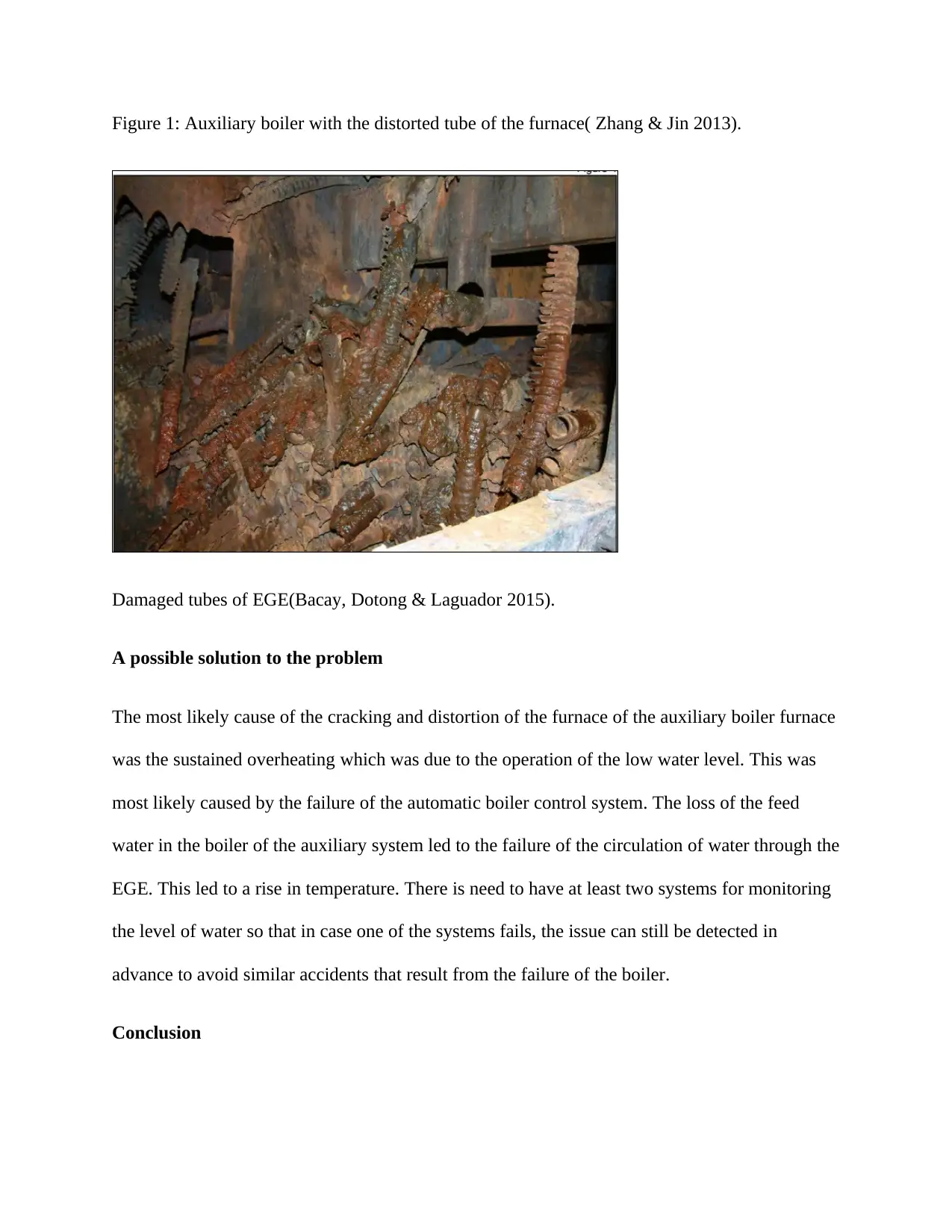
Figure 1: Auxiliary boiler with the distorted tube of the furnace( Zhang & Jin 2013).
Damaged tubes of EGE(Bacay, Dotong & Laguador 2015).
A possible solution to the problem
The most likely cause of the cracking and distortion of the furnace of the auxiliary boiler furnace
was the sustained overheating which was due to the operation of the low water level. This was
most likely caused by the failure of the automatic boiler control system. The loss of the feed
water in the boiler of the auxiliary system led to the failure of the circulation of water through the
EGE. This led to a rise in temperature. There is need to have at least two systems for monitoring
the level of water so that in case one of the systems fails, the issue can still be detected in
advance to avoid similar accidents that result from the failure of the boiler.
Conclusion
Damaged tubes of EGE(Bacay, Dotong & Laguador 2015).
A possible solution to the problem
The most likely cause of the cracking and distortion of the furnace of the auxiliary boiler furnace
was the sustained overheating which was due to the operation of the low water level. This was
most likely caused by the failure of the automatic boiler control system. The loss of the feed
water in the boiler of the auxiliary system led to the failure of the circulation of water through the
EGE. This led to a rise in temperature. There is need to have at least two systems for monitoring
the level of water so that in case one of the systems fails, the issue can still be detected in
advance to avoid similar accidents that result from the failure of the boiler.
Conclusion
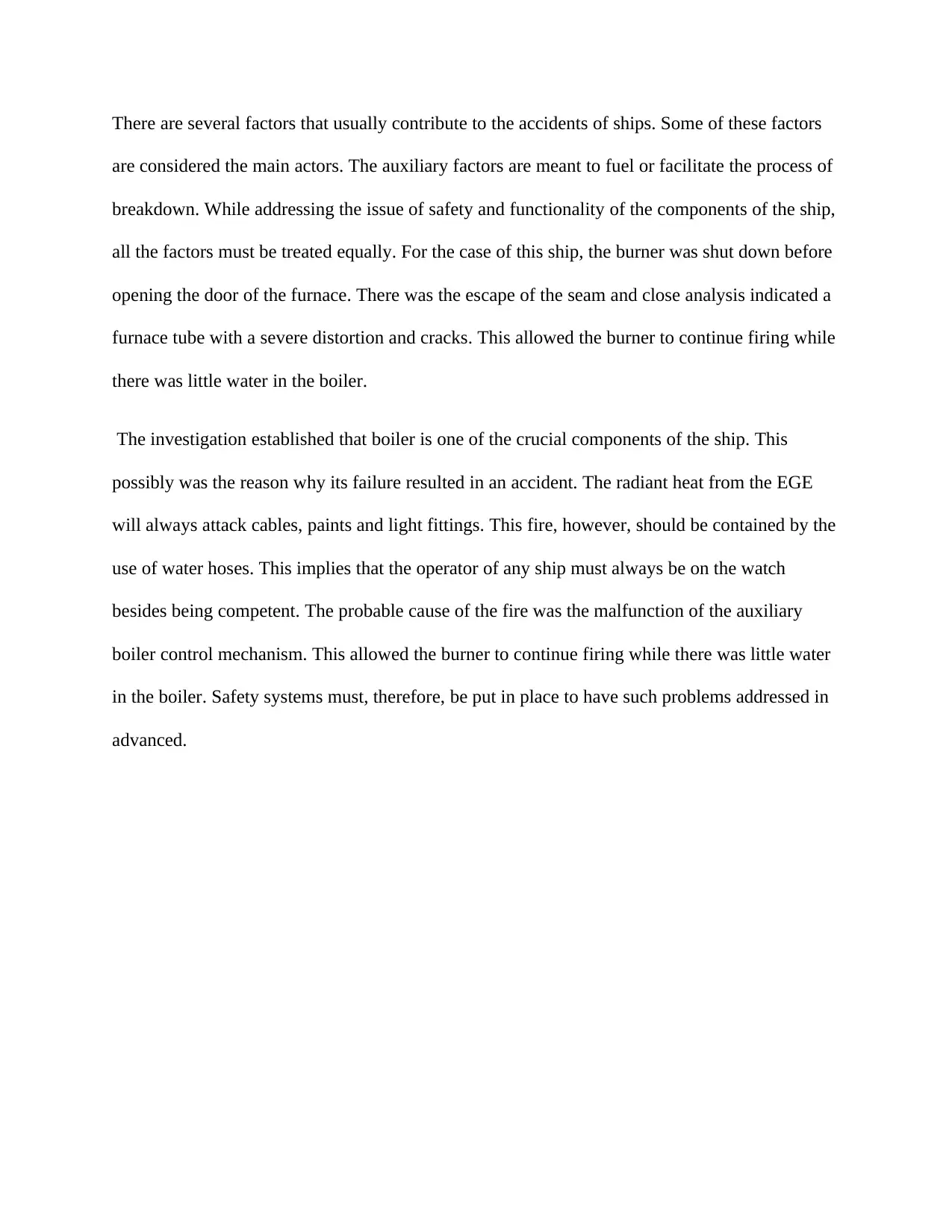
There are several factors that usually contribute to the accidents of ships. Some of these factors
are considered the main actors. The auxiliary factors are meant to fuel or facilitate the process of
breakdown. While addressing the issue of safety and functionality of the components of the ship,
all the factors must be treated equally. For the case of this ship, the burner was shut down before
opening the door of the furnace. There was the escape of the seam and close analysis indicated a
furnace tube with a severe distortion and cracks. This allowed the burner to continue firing while
there was little water in the boiler.
The investigation established that boiler is one of the crucial components of the ship. This
possibly was the reason why its failure resulted in an accident. The radiant heat from the EGE
will always attack cables, paints and light fittings. This fire, however, should be contained by the
use of water hoses. This implies that the operator of any ship must always be on the watch
besides being competent. The probable cause of the fire was the malfunction of the auxiliary
boiler control mechanism. This allowed the burner to continue firing while there was little water
in the boiler. Safety systems must, therefore, be put in place to have such problems addressed in
advanced.
are considered the main actors. The auxiliary factors are meant to fuel or facilitate the process of
breakdown. While addressing the issue of safety and functionality of the components of the ship,
all the factors must be treated equally. For the case of this ship, the burner was shut down before
opening the door of the furnace. There was the escape of the seam and close analysis indicated a
furnace tube with a severe distortion and cracks. This allowed the burner to continue firing while
there was little water in the boiler.
The investigation established that boiler is one of the crucial components of the ship. This
possibly was the reason why its failure resulted in an accident. The radiant heat from the EGE
will always attack cables, paints and light fittings. This fire, however, should be contained by the
use of water hoses. This implies that the operator of any ship must always be on the watch
besides being competent. The probable cause of the fire was the malfunction of the auxiliary
boiler control mechanism. This allowed the burner to continue firing while there was little water
in the boiler. Safety systems must, therefore, be put in place to have such problems addressed in
advanced.
Paraphrase This Document
Need a fresh take? Get an instant paraphrase of this document with our AI Paraphraser
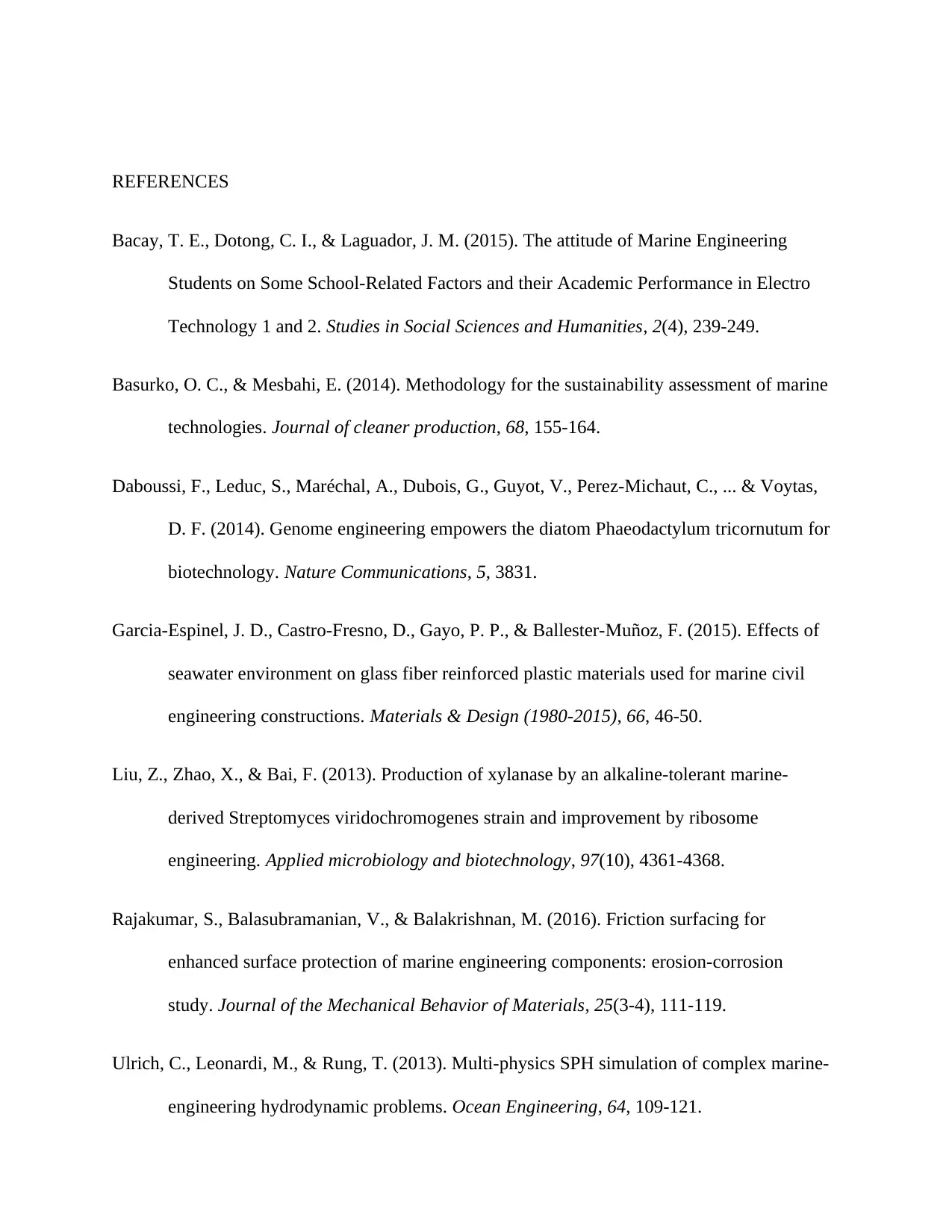
REFERENCES
Bacay, T. E., Dotong, C. I., & Laguador, J. M. (2015). The attitude of Marine Engineering
Students on Some School-Related Factors and their Academic Performance in Electro
Technology 1 and 2. Studies in Social Sciences and Humanities, 2(4), 239-249.
Basurko, O. C., & Mesbahi, E. (2014). Methodology for the sustainability assessment of marine
technologies. Journal of cleaner production, 68, 155-164.
Daboussi, F., Leduc, S., Maréchal, A., Dubois, G., Guyot, V., Perez-Michaut, C., ... & Voytas,
D. F. (2014). Genome engineering empowers the diatom Phaeodactylum tricornutum for
biotechnology. Nature Communications, 5, 3831.
Garcia-Espinel, J. D., Castro-Fresno, D., Gayo, P. P., & Ballester-Muñoz, F. (2015). Effects of
seawater environment on glass fiber reinforced plastic materials used for marine civil
engineering constructions. Materials & Design (1980-2015), 66, 46-50.
Liu, Z., Zhao, X., & Bai, F. (2013). Production of xylanase by an alkaline-tolerant marine-
derived Streptomyces viridochromogenes strain and improvement by ribosome
engineering. Applied microbiology and biotechnology, 97(10), 4361-4368.
Rajakumar, S., Balasubramanian, V., & Balakrishnan, M. (2016). Friction surfacing for
enhanced surface protection of marine engineering components: erosion-corrosion
study. Journal of the Mechanical Behavior of Materials, 25(3-4), 111-119.
Ulrich, C., Leonardi, M., & Rung, T. (2013). Multi-physics SPH simulation of complex marine-
engineering hydrodynamic problems. Ocean Engineering, 64, 109-121.
Bacay, T. E., Dotong, C. I., & Laguador, J. M. (2015). The attitude of Marine Engineering
Students on Some School-Related Factors and their Academic Performance in Electro
Technology 1 and 2. Studies in Social Sciences and Humanities, 2(4), 239-249.
Basurko, O. C., & Mesbahi, E. (2014). Methodology for the sustainability assessment of marine
technologies. Journal of cleaner production, 68, 155-164.
Daboussi, F., Leduc, S., Maréchal, A., Dubois, G., Guyot, V., Perez-Michaut, C., ... & Voytas,
D. F. (2014). Genome engineering empowers the diatom Phaeodactylum tricornutum for
biotechnology. Nature Communications, 5, 3831.
Garcia-Espinel, J. D., Castro-Fresno, D., Gayo, P. P., & Ballester-Muñoz, F. (2015). Effects of
seawater environment on glass fiber reinforced plastic materials used for marine civil
engineering constructions. Materials & Design (1980-2015), 66, 46-50.
Liu, Z., Zhao, X., & Bai, F. (2013). Production of xylanase by an alkaline-tolerant marine-
derived Streptomyces viridochromogenes strain and improvement by ribosome
engineering. Applied microbiology and biotechnology, 97(10), 4361-4368.
Rajakumar, S., Balasubramanian, V., & Balakrishnan, M. (2016). Friction surfacing for
enhanced surface protection of marine engineering components: erosion-corrosion
study. Journal of the Mechanical Behavior of Materials, 25(3-4), 111-119.
Ulrich, C., Leonardi, M., & Rung, T. (2013). Multi-physics SPH simulation of complex marine-
engineering hydrodynamic problems. Ocean Engineering, 64, 109-121.

Zhang, J. H., & Jin, J. Y. (2013). Marine delimitation method based on earth ellipsoid
model. The science of Surveying and Mapping, 38(3), 16-17.
Zhang, Y., Li, X., Bartlett, D. H., & Xiao, X. (2015). Current developments in marine
microbiology: high-pressure biotechnology and the genetic engineering of
piezophiles. Current opinion in biotechnology, 33, 157-164.
model. The science of Surveying and Mapping, 38(3), 16-17.
Zhang, Y., Li, X., Bartlett, D. H., & Xiao, X. (2015). Current developments in marine
microbiology: high-pressure biotechnology and the genetic engineering of
piezophiles. Current opinion in biotechnology, 33, 157-164.
1 out of 9
Your All-in-One AI-Powered Toolkit for Academic Success.
+13062052269
info@desklib.com
Available 24*7 on WhatsApp / Email
![[object Object]](/_next/static/media/star-bottom.7253800d.svg)
Unlock your academic potential
© 2024 | Zucol Services PVT LTD | All rights reserved.